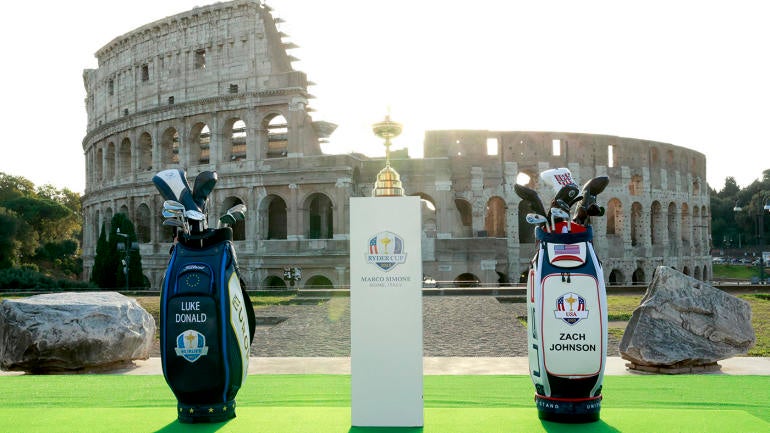
For the first time in the nearly 100-year history of the event, Rome will serve as the stage for the 2023 Ryder Cup. This is exciting and enthralling, especially given how close the United States and European teams seem to be in talent and momentum. While Marco Simone might not be the greatest golf course at which this event has ever been hosted, the global stage that Rome provides is tremendous for the sport.
Throw in how similar the two teams are in talent, how much momentum both have accumulated and how fans are due ffor an actually close and competitive Ryder Cup, and the 44th edition of the event has a chance to be one of the all-time greats.
Let's take a look now at nine storylines that have a chance to dominate the headlines as the 2023 Ryder Cup approaches.
2023 Ryder Cup storylines
1. Thirty years: You will hear this approximately 1,450 times during next week's broadcasts, but 1993 was the last time the United States team won a Ryder Cup on European soil. That's obviously a long time, but this is obviously a different team than recent U.S. teams that have traveled across the Atlantic Ocean (more on that below). While this is a storyline -- maybe the storyline -- for the week, how Lee Janzen played at the 1997 Ryder Cup in Spain has zero influence on how Brooks Koepka plays at the Ryder Cup in 2023.
The way you will likely hear this framed on the U.S. side is that though history exists (and even matters), there is a self-belief among this group that is unique -- a belief that probably borders on the arrogance of We're actually the group to break this streak. Webb Simpson said this recently on the "Five Clubs" podcast with Gary Williams.
Our @rydercup preview show is out and @webbsimpson1 joined the crew to dive into all that lies ahead in Rome in a couple weeks including the confidence of @RyderCupUSA @Garywilliams1Up | @johnson_wagner | @BrendonDeJonge
— 5 Clubs (@5ClubsGolf) September 18, 2023
Watch Full Episode: https://t.co/rGftZ622Il
Listen:… pic.twitter.com/haL0WeM9YL
Results over the last 30 years won't matter much to those guys in the heat of battle on Friday, Saturday and Sunday, but it will give them a rallying cry throughout the week.
2. Justin Thomas' response: Never has the 12th player (OK, maybe 11th player) on a Ryder Cup team received as much attention as Thomas over the last month. I have folks tweeting at me that they're not going to watch the event because of how flawed the selection process is, which ... OK, cool. There has been scrutiny, for sure, but J.T.'s inclusion on this year's team is emblematic of a bigger sea change on the U.S. side.
Gone are the days when they simply rolled out talent and tried to out-birdie the Europeans. That obviously has not worked (see point No. 1). Thomas is representative of a U.S. team that seemingly cares more about both the event and each other than perhaps any U.S. team that has gone to Europe over the last 30 years.
Here's a stat: The second-oldest player on this team is Rickie Fowler. All of these guys grew up caring about the Ryder Cup and have been galvanized around each other. Remember what Koepka said at Whistling Straits?
Brooks: “It’s a different group of guys. It’s a lot more fun than in years past.” 👀
— Kyle Porter (@KylePorterCBS) September 26, 2021
The outcome might be similar to the last several Ryder Cups in Europe, but the foot the U.S. is putting forward is far more enthusiastic and on more stable ground than it has been in a long time. That doesn't guarantee a win, but it does give them a chance.
3. Overall home-field advantage: Other than the Miracle at Medinah, the home team has won the Ryder Cup every year since 2006. The 30-year drought is one thing, but what stands out even more is just how much of an advantage both home teams have had in recent years and the pressure that puts on the other side. Jordan Spieth spoke about this at the event-ending press conference at Whistling Straits.
"We needed to win this one," said Spieth. "It was a massive stepping stone for this team and the group we have here -- who have known each other since almost back to grade school -- to continue to work hard to be on these teams to go over there. It's one thing to win it here, and it is a lot easier here to do so. It is harder to win it over there. If we play like we did this week the score will look the same over there in a couple of years and that's what we're here for."
I think about this clip from Whistling Straits probably more often than I should. pic.twitter.com/SMmeBFsCHy
— Kyle Porter (@KylePorterCBS) September 22, 2023
4. Course setup: Here's where it starts to get interesting. Part of the reason the European side has had an advantage on European soil is because it has traditionally been more adept at playing a different brand of golf than the Americans. Now? Almost everyone on the European side plays the same PGA Tour events weekly as those on the American side. The skillsets at an event like this have become more homogenous.
Interesting dynamic for this year's Ryder Cup...
— Jamie Kennedy (@jamierkennedy) September 4, 2023
Narrative: "US team is longer than Europe"
Fact: US team averages 305.6, Europe 308.5
Narrative: "Europeans are more accurate"
Fact: Europe's driving accuracy is 59.7%, US 60.3%
In light of this, I'll be curious to see if the Europeans do what they did in Paris to Marco Simone. Do they pinch the fairways, grow the rough and try to take driver out of the hands of everyone given that, you know, maybe the three best drivers in the event (and the world) are Europeans?
Rory McIlroy went on the Subpar Podcast a few weeks ago and said that Europe wanted to take wedges out of the Americans' hands and turn the competition into a driving, long iron and putting contest. So it seems like they're going to try and optimize for elite driving but also long iron play. The way to do this is by making holes extremely short (drivable par 4s) or extraordinarily long, which could be the case when the teams tee it up.
This intrigues me, mostly because I disagree with it. I think it generally helps the Americans to present them a driving and long iron contest. Regardless, this aspect of the event has never been more intriguing to me than it is this week, and course setup will be one of the primary talking points throughout the first four days of practice rounds in Rome.
5. What (record) do we get from Rory? Speaking of McIlroy, he's 3-6-0 in the last two Ryder Cups. You can explain that away by saying that Le Golf National was not a great setup for what he does (see above) and that he was playing pretty poor golf in 2021 as he sat out a session for the first time ever. And while the European side might not need him to go 5-0-0 to win, the teams are seemingly so close in talent and form that if he goes 1-3-0 like he did at Whistling Straits, J.T. and Spieth might be recreating this video on Sunday evening.
Hey Tiger and Rory …
— PGA TOUR (@PGATOUR) December 11, 2022
WHAT HAPPENED?!?! pic.twitter.com/twrgI3C6pP
It's more than that with McIlroy, too. In the same way that Thomas is the soul of the U.S. team, McIlroy is the same on the European side and has been for quite a while. They go emotionally as he goes, and he's long been up for that fight. The hatless maniac, running around Marco Simone bowing and screaming and probably cursing in delight. That part seems baked in, especially if he gets somebody like Ludvig Aberg as a teammate. The bigger question for me is whether his recent run of great play will translate to 3-5 points on the actual scoreboard.
6. Foursomes probs: The U.S. is 2-12-2 in foursomes in the last two Ryder Cups in Europe. I don't know how they solve this or figure it out, but it's probably what this year's edition hinges upon.
7. Scottie Scheffler's putter: We talked a lot about it over the last few months of the PGA Tour season. And while there will certainly be less pressure on him to make putts with a teammate (especially one who is a good putter like Sam Burns), this will still be a focus on the U.S. side. Like it or not, there is an energy associated with taking down the No. 1 player in the world. Scheffler actually played this role in 2021, roasting Jon Rahm in singles and basically paving the way to victory for the U.S. Can he hold his ground in 2023 help the U.S. to the same this time around?
8. New Euro blood: There are not a lot of questions on the U.S. side when it comes to pairings. There are questions, however, on the European side. For example, the only player on this team who Rory McIlroy has played with in a Ryder Cup before is Shane Lowry, and that was one time two years ago. Justin Rose has only played with one other golfer on this team, and that was Jon Rahm five years ago. It's going to be fascinating to see how captain Luke Donald arranges everything -- specifically who gets paired with the red-hot Ludvig Aberg.
Ryder Cup press conference schedule is out, and could give a hint into potential "pods" and pairings.
— Sean Martin (@PGATOURSMartin) September 22, 2023
The U.S. is divided into groups of 4 for interviews.
Cantlay/Schauffele/Spieth/Thomas
Wyndham/Rickie/Homa/Morikawa
Burns/Harman/Koepka/Scheffler
Europe has two groups of 6:…
We might still be underrating the fact that Aberg was playing college golf at Texas Tech at the start of this year and now he's going to playing Scheffler and Spieth in the Ryder Cup. His talent is off the charts, and there is some fear on the American side -- not from the team, but from fans -- that he might get McIlroy as a partner. Shades of Thomas Pieters and McIlroy destroying worlds in 2016 at Hazeltine. That is not something I'm excited to relive.
9. Will this live up to the hype? It's been a while, hasn't it? The Miracle at Medinah in 2012 was one of the all-time great Ryder Cups, but it's been a wasteland of drama since then. This year's event seems like it's going to be close, but seems like and is are two very different things. Still, there is opportunity for something titanic on Sunday. There is no tension in sport like "the Ryder Cup is tied 12-12 with four matches still being played on the final five holes" tension.
There's nothing like it. Nothing that happens once every two years (and once every four on your own continent) that is so revered and so meaningful to everyone involved. There's nowhere else where a three-days-every-24-months team means this much. Nowhere else you feel the weight that you feel when you're alone on the course Sunday afternoon.
Where might that lead? Perhaps a Spieth-Viktor Hovland clash late with the trophy in the balance? Maybe Tommy Fleetwood running laps around Patrick Cantlay early to put the Americans away? Or Brooks Koepka and Jon Rahm waging a war of titans?
What if, though ... what if we get Rory and J.T. with the event tied at 13.5 and the U.S. needing a half point and Europe needing it all? What if that happens? What if, after two straight years of a lot of nonsense in professional golf, we somehow get the center of both teams all square after 15 holes with 22 other players unable to watch and the rest of the world unwilling to look away?
What if that happens? It almost certainly will not. But ... what if it does?

















